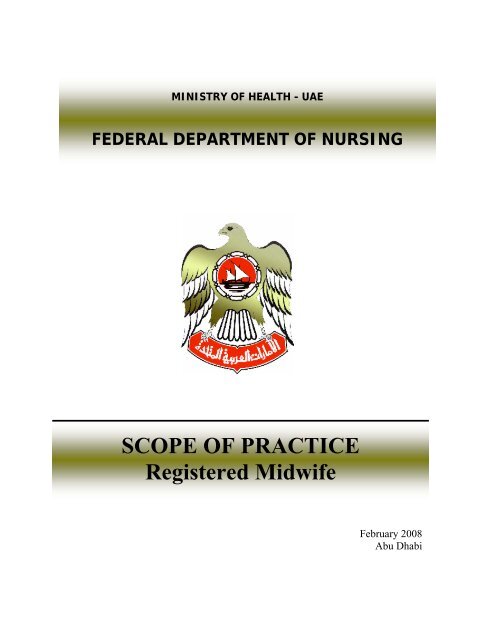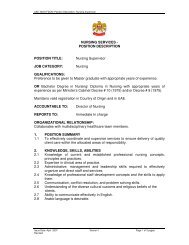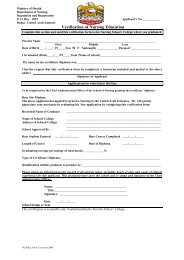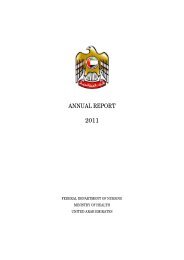SCOPE OF PRACTICE Registered Midwife - Federal Department of ...
SCOPE OF PRACTICE Registered Midwife - Federal Department of ...
SCOPE OF PRACTICE Registered Midwife - Federal Department of ...
You also want an ePaper? Increase the reach of your titles
YUMPU automatically turns print PDFs into web optimized ePapers that Google loves.
MINISTRY <strong>OF</strong> HEALTH - UAEFEDERAL DEPARTMENT <strong>OF</strong> NURSING<strong>SCOPE</strong> <strong>OF</strong> <strong>PRACTICE</strong><strong>Registered</strong> <strong>Midwife</strong>February 2008Abu Dhabi
<strong>SCOPE</strong> <strong>OF</strong> <strong>PRACTICE</strong><strong>Registered</strong> <strong>Midwife</strong>Table <strong>of</strong> contentTitle PageTable <strong>of</strong> ContentIntroductionDomain <strong>of</strong> <strong>Midwife</strong>ry PracticeDomain 1: <strong>Midwife</strong>ry Practice and Comprehensive CareDomain 2: Pr<strong>of</strong>essional, Legal and Ethical PracticeDomain 3: Pr<strong>of</strong>essional DevelopmentDefinitionsReferencesIssued: February 2008 Version 1.0 UAE-MOH: FDON / Page 2 <strong>of</strong> 15
<strong>SCOPE</strong> <strong>OF</strong> <strong>PRACTICE</strong><strong>Registered</strong> <strong>Midwife</strong>IntroductionThe following <strong>Midwife</strong>ry competency framework has been developed in collaboration withnursing representatives from all Emirates in the attempt to facilitate consistency inmidwifery standards throughout the UAE and has been adopted by the Health Authority <strong>of</strong>Abu Dhabi (HAAD) and Dubai Health authority (DHA).In 2000, the Eastern Mediterranean Region Office (EMRO) <strong>of</strong> the World HealthOrganisation (WHO) identified, at a Global Advisory Group meeting on Nursing and<strong>Midwife</strong>ry, a number <strong>of</strong> challenges being faced by governments and providers in thisregion for midwifery (and nursing) services: increased demand for midwifery educationand services which parallels the incremental population growth, provision <strong>of</strong> evidencebasedpractice, quality improvement <strong>of</strong> clinical practice and more formalized systems <strong>of</strong>nursing regulation (p.14). It has also been raised by Buscher and Wagner (2004), thatmidwives (and nurses) are not working to their full potential in this region, with “…lack <strong>of</strong>adequate legislation [being] identified as the most prevailing reason, including the needfor a definition <strong>of</strong> roles and scope <strong>of</strong> practice” (p.12).The following document seeks to address some <strong>of</strong> these concerns through defining aScope <strong>of</strong> Practice with associated competency standards for the practicing midwife in theUAE, to provide a basis for regulation and licensure for midwifery practice. As hasrecently been declared by the ICM/WHO/ICN in Islamabad, “All people should haveaccess to competent nurses and midwives who provide care, supervision and support inall settings” (March 2007); therefore UAE Midwives need a set <strong>of</strong> competency standardsto frame practice to encompass education, counseling, care and support to women andfamilies throughout pregnancy, labour, birth and the postnatal period. Accepting that careis holistic and aims to meet social, emotional, cultural, spiritual and physical needs <strong>of</strong> awoman’s reproductive health experience, entry to practice midwifery competence needsto be based upon successful completion <strong>of</strong> an approved midwifery educational program.In developing the <strong>Midwife</strong>ry Scope, consideration has been given to the UAE MOHPr<strong>of</strong>essional Code <strong>of</strong> Conduct (2001), the FDON Scope <strong>of</strong> Practice for the <strong>Registered</strong>Nurse and/or <strong>Midwife</strong> (2004), the International Confederation <strong>of</strong> Midwives (ICM)Philosophy and Model <strong>of</strong> <strong>Midwife</strong>ry Care (2005), together with a detailed review <strong>of</strong>international practice scopes to ensure that the final document is current and relevant tothe UAE social context. One <strong>of</strong> the difficulties faced when attempting to define midwiferycompetency is the complex nature <strong>of</strong> practice and the wide variety <strong>of</strong> knowledge, skillsIssued: February 2008 Version 1.0 UAE-MOH: FDON / Page 3 <strong>of</strong> 15
and attributes that are necessary in providing midwifery care in very different settings. Inaddition to the above documents, the ICM Essential Competencies for Basic <strong>Midwife</strong>ryPractice (2002) has been a useful guide in the development <strong>of</strong> the UAE <strong>Midwife</strong>ry scope<strong>of</strong> practice.<strong>Midwife</strong>ry practice describedMidwives have been identified as being pivotal in not only primary health care programswithin the community, but in playing a critical role in facilitating the health <strong>of</strong> the nation inwhich they work (ICM, 2007). While pregnancy and childbirth are considered normal lifeevents, it is the midwife who has been identified as the most appropriate and costeffective health care pr<strong>of</strong>essional to provide care in normal pregnancy and childbirth,including risk assessment and recognition <strong>of</strong> complications (WHO, 1995).WHO recognizes that midwives, who are allowed to use the full range <strong>of</strong> their skills, canpositively impact upon maternal and perinatal mortality and morbidity rates (WHO, 1994).Women are placed at the centre <strong>of</strong> midwifery care, where wellness is promoted throughestablishing partnerships with women to promote self-care which affects not onlyindividual health, but that <strong>of</strong> the family. The key concepts identified by the ICM whichhelp define midwifery practice include respect for human dignity, advocacy for women,cultural sensitivity, a focus on health promotion and disease prevention, equity <strong>of</strong> statusfor women and a commitment to improvement <strong>of</strong> basic living conditions as well asproviding competent midwifery services (ICM, 2005).A midwife may thus be defined:“A midwife is a person who, having been regularly admitted to a midwiferyeducational programme, duly recognized in the country in which it is located, hassuccessfully completed the prescribed course <strong>of</strong> studies in midwifery and hasacquired the requisite qualifications to be registered and/or legally licensed topractise midwifery” (ICM, 2005)A midwife is responsible and accountable for her own practice and is able to workindependently, yet collaboratively with other health care pr<strong>of</strong>essionals. Competency topractice necessitates ongoing reflection and evaluation <strong>of</strong> own performance, with thisprocess being facilitated by considering the practice standards specified in the followingScope <strong>of</strong> Practice document.Inherent within the Scope <strong>of</strong> Practice is the need to demonstrate safe practice. Safety topractice as a midwife is evident when applicants for registration meet the competenciesidentified by the regulatory authority. The Scope <strong>of</strong> Practice has therefore beendeveloped to ensure that the public <strong>of</strong> the UAE can be confident in the abilities <strong>of</strong>midwives in the provision <strong>of</strong> safe and effective midwifery care.Three Domains <strong>of</strong> Practice have been identified. Core midwifery competency standardsand associated performance criteria are located within these three domains <strong>of</strong> practice.Domains <strong>of</strong> PracticeIssued: February 2008 Version 1.0 UAE-MOH: FDON / Page 4 <strong>of</strong> 15
1. <strong>Midwife</strong>ry Practice and Comprehensive Care2. Pr<strong>of</strong>essional, Legal and Ethical Practice3. Pr<strong>of</strong>essional DevelopmentCompetency StatementsEach Domain <strong>of</strong> Practice has competency statements and associated performancecriteria that a midwife must demonstrate to fulfil regulatory and registration requirements.A competency is a combination and integration <strong>of</strong> knowledge, skills and attitudes whichresult in effective performance (ACMI, 2001). These essential competencies for basicmidwifery practice are based on values, vision, strategies and actions used by midwiveswho attend to the health needs <strong>of</strong> women and childbearing families. Performance criteriaare the measurable outcomes that underpin the competency.Competence is not static and knowledge underpinning the rationale may change overtime. New knowledge influences practice. These competency statements decreed by theregulatory authority will therefore be reviewed and adapted to keep abreast <strong>of</strong>developments in practice.Issued: February 2008 Version 1.0 UAE-MOH: FDON / Page 5 <strong>of</strong> 15
Domain 1: <strong>Midwife</strong>ry Practice and Comprehensive CareThis domain relates to aspects <strong>of</strong> a registered midwife’s performance and behaviourwhich indicates she has the relevant knowledge, skills and attitudes to practice accordingto the international definition <strong>of</strong> midwife. The competency standards in this domain haveexpected performance outcomes that reflect the midwife’s ability to provide evidencebased, safe and effective midwifery care which is <strong>of</strong> high quality, culturally relevant andappropriate for women, newborn and childbearing families in a variety <strong>of</strong> settings.Competency 1.1 Promotes health and provides education to the womanand her familyMidwives provide high quality, culturally sensitive health education and services to allwomen and their families in order to promote healthy family life, planned pregnancies andpositive parenting.Performance criteria• Identifies, participates in and contributes to the development <strong>of</strong> health educationprograms in the community• Provides women and their families with accurate information• Supports women and their families to promote health and well-beingCompetency 1.2 Facilitates decision-making by the woman and herfamilyMidwives provide evidence-based information to women and their families facilitatingthem to make informed choices regarding their care.Performance criteria:• Offers advice and midwifery care that respects the cultural and social needs <strong>of</strong>each woman and her family• Communicates relevant information effectively, using language that is readilyunderstood• Actively listens to the woman and her family and responds to their needs• Facilitates learning opportunities through sharing <strong>of</strong> information• Advocates informed choice and shared decision-makingCompetency 1.3 Provides safe and effective antenatal careMidwives provide high quality antenatal care to maximize health during pregnancy whichincludes prevention, early detection and treatment or referral <strong>of</strong> selected complications.Performance criteria:1.3.1 Promotes the health and well-being <strong>of</strong> the pregnant woman and the foetus• Uses the nursing process to plan, implement and evaluate holistic antenatal care incollaboration with the woman and significant others• Educates women and families about normal physiological changes <strong>of</strong> pregnancyand advise on strategies to relieve common discomforts• Assesses the growth and well-being <strong>of</strong> the foetusIssued: February 2008 Version 1.0 UAE-MOH: FDON / Page 6 <strong>of</strong> 15
• Provides nutritional advise for pregnancy and lactation• Interprets and acts upon information from antenatal assessments• Interprets and analyses basic screening laboratory/ultrasound studies• Identifies health risk factors and refers care as necessary1.3.2 Prepares the woman for labour, birth and parenting• Educates the woman about the onset and process <strong>of</strong> labour• Provides information about pain relief, birth positions and delivery options t<strong>of</strong>acilitate informed choices• Protects, promotes and supports breastfeeding in alignment with currentWHO/UNICEF guidelinesCompetency 1.4 Provides safe and effective intrapartum careMidwives provide high quality, culturally sensitive care during labour, conduct a safedelivery, and respond in emergency situations to maximise the health <strong>of</strong> women and thenewborn.Performance criteria:1.4.1 Demonstrates an understanding <strong>of</strong> the physiology <strong>of</strong> labour• Recognizes the relevant critical diameters and landmarks <strong>of</strong> the maternalreproductive anatomy• Identifies the signs which indicate onset and progress <strong>of</strong> labour• Identifies the measures to assess foetal and maternal well-being in labour• Identifies the signs and indicators <strong>of</strong> complications1.4.2 Demonstrates competency in the skills needed to support the womanduring childbirth• Promotes normal physiological childbirth• Identifies complications or deviations from the norm• Implements midwifery care which reduces risk and harm• Encourages and respects woman’s preferences throughout labour and delivery,involving the family as requested• Recognizes emergency situations and intervenes in a timely mannerCompetency 1.5: Provides safe and effective postnatal careMidwives provide comprehensive, high quality culturally sensitive postnatal care forwomen and the newborn.Performance criteria:1.5.1 Demonstrates an understanding <strong>of</strong> the physiology <strong>of</strong> the puerperium• Identifies the normal process <strong>of</strong> involution and healing following childbirth• Facilitates the process <strong>of</strong> lactation and bonding, supporting the mother-infant dyad• Recognises maternal nutritional, physiological and emotional needs and actsaccordingly• Educates the woman about discomforts <strong>of</strong> the puerperium and advises onstrategies to relieve them• Recognises complications and acts accordinglyIssued: February 2008 Version 1.0 UAE-MOH: FDON / Page 7 <strong>of</strong> 15
1.5.2 Demonstrates competency in the skills needed to support the woman andher family during the postnatal period• Uses the nursing process to plan, implement and evaluate holistic postnatal care incollaboration with the woman and significant others• Performs focused physical examinations <strong>of</strong> the mother• Initiates and supports uninterrupted (exclusive) breastfeeding• Provides support for women who make an informed decision not to breastfeed• Counsels and provides education for the woman and her family on reproductivehealth issues, including sexuality, family planning and bereavementCompetency 1.6: Provides safe and effective care <strong>of</strong> the newbornMidwives provide high quality, comprehensive care for essentially healthy newborn frombirth to six weeksPerformance criteria:1.6.1 Demonstrates a basic knowledge <strong>of</strong> the physiology and needs <strong>of</strong> thenewborn• Recognises signs <strong>of</strong> newborn adaptation to extra-uterine life• Identifies factors relevant to infant growth and development• Identifies variations in the normal newborn and acts accordingly• Implements health promotion and disease prevention strategies1.6.2 Demonstrates competency in the skills needed to safely care for thenewborn• Evaluates the newborn’s condition using the Apgar score at 1 and 5 minutes• Performs an initial assessment <strong>of</strong> the newborn’s appearance and behaviour• Performs a detailed physical examination <strong>of</strong> the newborn• Positions the newborn for effective breastfeeding• Performs interventions to facilitate adaptation to extra-uterine life• Recognises complications and acts accordingly• Initiates emergency measures when necessaryCompetency 1.7 Performs safe and effective pharmacologicalinterventionsMidwives are able to administer 1 relevant pharmacological substances safely andeffectively according to legislation within the UAEPerformance criteria:1.7.1 Demonstrates evidence based practice in use <strong>of</strong> pharmacologicalpreparations relevant to midwifery practice• Educates the woman about the potential effects <strong>of</strong> medication during pregnancy,birth and lactation• Educates the woman about any medications required by the newborn• Accurately calculates medication doses for administration1 See Definitions for statement on Advanced Practice including prescribing rights for MidwivesIssued: February 2008 Version 1.0 UAE-MOH: FDON / Page 8 <strong>of</strong> 15
• Safely administers medications during pregnancy, birth and lactation• Recognizes contra-indications and side effects and acts accordingly• Documents medication administration accuratelyIssued: February 2008 Version 1.0 UAE-MOH: FDON / Page 9 <strong>of</strong> 15
Domain 2: Pr<strong>of</strong>essional, Legal and Ethical PracticeThis domain reflects the registered midwife’s legal and pr<strong>of</strong>essional accountability towomen and their families, the community, relevant regulatory authorities and employers,for all elements <strong>of</strong> clinical practice and decision making. This necessitates autonomy topractice within a scope <strong>of</strong> competency and an ability to work independently and incollaboration with others.Competency 2.1 Functions in accordance with legislative and policyguidelines relevant to midwifery practicePerformance criteria:• Maintains current license to practice as an outcome <strong>of</strong> self-regulation• Identifies unsafe practice and intervenes accordingly• Functions within a set midwifery scope <strong>of</strong> practice as delineated by this document• Practices only to the level for which she is adequately prepared, supervised andsupported to perform• Utilizes relevant codes <strong>of</strong> conduct as a guide to midwifery practice• Contributes to policy development impacting on midwifery practice• Interacts with policy makers and legislators to influence legislation and regulationpertaining to midwifery practice• Documents midwifery care accuratelyCompetency 2.2 Assumes responsibility and accountability for ownactions and clinical decision makingPerformance criteria:• Performs ongoing self-evaluation to determine strengths and limitations inknowledge and skills• Consults and performs referrals as necessary• Assumes responsibility for delegation and supervision <strong>of</strong> midwifery care (direct andindirect), which is relevant to the context and the competence <strong>of</strong> the person towhom care is delegated• Accepts responsibility for delegated activities relevant to the context and own level<strong>of</strong> competence• Works collaboratively with other health care pr<strong>of</strong>essionals to improve the delivery<strong>of</strong> services to women and families• Advocates for women and families to ensure promotion <strong>of</strong> a healthy and safe birthCompetency 2.3 Delivers care and practices midwifery within an ethicalframework and social contextPerformance criteria:• Implements midwifery care in a culturally respectful and non-judgmental manner• Bases midwifery practice on ethical decision making• Works in partnership with women to support them in making informed choicesabout their healthIssued: February 2008 Version 1.0 UAE-MOH: FDON / Page 10 <strong>of</strong> 15
• Acts to strengthen women in promoting health <strong>of</strong> self and others• Communicates effectively with women, families and health care pr<strong>of</strong>essionals tooptimize care• Advocates to protect rights <strong>of</strong> women and families in relation to midwifery careIssued: February 2008 Version 1.0 UAE-MOH: FDON / Page 11 <strong>of</strong> 15
Domain 3: Pr<strong>of</strong>essional DevelopmentThis domain acknowledges that each midwife is accountable for establishing, maintainingand evaluating their own life long learning needs to ensure continuing competence topractice. Pr<strong>of</strong>essional development includes not only development <strong>of</strong> self, but acommitment to the development <strong>of</strong> others and the pr<strong>of</strong>ession, to facilitate high qualitycare delivery and enhancement <strong>of</strong> pr<strong>of</strong>essional standards.Competency 3.1 Demonstrates a commitment to development <strong>of</strong> selfPerformance criteria:• Maintains knowledge and skills through actively participating in continuingpr<strong>of</strong>essional development programs• Uses valid research to inform midwifery practice• Actively engages in continuous self-assessment to evaluate and enhance ownpractice• Maintains record <strong>of</strong> all learning and pr<strong>of</strong>essional development activities attendedCompetency 3.2 Demonstrates a commitment to development <strong>of</strong> othersand the pr<strong>of</strong>essionPerformance criteria:• Collaborates and shares pr<strong>of</strong>essional knowledge with others• Supports others less experienced or new to the pr<strong>of</strong>ession through formal andinformal preceptor and mentor programs• Participates in facilitating and co-ordinating learning opportunities for others• Contributes to health care policy as relevant to midwifery practice• Identifies opportunities and contributes to nursing research• Refers to and disseminates current research to guide midwifery practiceIssued: February 2008 Version 1.0 UAE-MOH: FDON / Page 12 <strong>of</strong> 15
DefinitionsAdvanced/ extended practiceClinical practice which lies outside this <strong>Midwife</strong>ry scope is considered as extendedpractice, which requires additional approved/accredited education and training to ensurethe <strong>Midwife</strong> has the knowledge and skills necessary to perform at an advanced levelbeyond the stated core competencies expected at level <strong>of</strong> entry to practice. Examples <strong>of</strong>such roles might include direct referral <strong>of</strong> clients to other health care pr<strong>of</strong>essionals,prescribing <strong>of</strong> medications, and ordering <strong>of</strong> diagnostic investigations. Such advancedpractice involves care delivery at levels <strong>of</strong> greater complexity and are usually recognisedthrough formal systems <strong>of</strong> certification and privileging. Regulatory systems for advancedpractice licensure is not available at this stage in the UAE, thus <strong>Midwife</strong>ry licensure isguided by the basic core competencies as presented in this Scope <strong>of</strong> Practice.Competence‘…the combination <strong>of</strong> skills, knowledge, attitudes, values and abilities that underpineffective and/or superior performance in a pr<strong>of</strong>ession / occupational area’ (ANMCNational Competency Standards for the <strong>Registered</strong> Nurse, 2006)<strong>Registered</strong> <strong>Midwife</strong>After completion <strong>of</strong> secondary school education, graduation from a midwifery programme<strong>of</strong> at least three (3) years duration OR graduation from a midwifery programme <strong>of</strong> at leasttwelve (12) months duration after completion <strong>of</strong> a three (3) year nursing programme, witha pro<strong>of</strong> <strong>of</strong> academic achievement <strong>of</strong> at least sixty percent (60%) <strong>of</strong> total marks.ScopeIs the breadth <strong>of</strong> clinical practice which a midwife is expected to competently performwithin a specific context, and for which they are educated and legally authorised to do so.Significant othersIndividual(s) who have a meaningful relationship with the woman before, during or afterchildbirth and who are considered to play an important role in her life. Within midwiferypractice these may be, for example the marriage partner/spouse, family members,friends, colleagues, religious and other human support resources (FDON-MOH, 2004)Issued: February 2008 Version 1.0 UAE-MOH: FDON / Page 13 <strong>of</strong> 15
ReferencesACMI (2001). Australian College <strong>of</strong> Midwives Incorporated Competency Standards forMidwives. http://www.acmi.org.auAn Bord Altranais. (April, 2000). Scope <strong>of</strong> Nursing and <strong>Midwife</strong>ry Practice Framework.http://www.nursingboard.ie/en/publications_current.aspxANMC. (2006) Australian Nursing and <strong>Midwife</strong>ry Council National CompetencyStandards for the Nurse Practitioner.http://www.anmc.org.au/docs/Publications/Competency%20Standards%20for%20the%20Nurse%20Practitioner.pdfAustralian Nursing and <strong>Midwife</strong>ry Council. (2007) Information for <strong>Registered</strong> Nursesregarding visas and immigration to Australia. http://www.australiamigration.com/page/Nurses_ANC/257Australian Nursing and <strong>Midwife</strong>ry Council. (2006) National Competency standards forthe <strong>Midwife</strong>.Buscher, A., Wagner, L. (2004). Munich Declaration: nurses and midwives: A force forhealth. An Analysis <strong>of</strong> implementation <strong>of</strong> the Munich Declaration 2004 (WHOpublication). http://www.euro.who.int/document/e86640.pdf<strong>Federal</strong> <strong>Department</strong> <strong>of</strong> Nursing, MOH, UAE. (2004). Scope <strong>of</strong> Practice <strong>Registered</strong>Nurse and/or <strong>Midwife</strong>. Abu Dhabi: Author<strong>Federal</strong> <strong>Department</strong> <strong>of</strong> Nursing, MOH, UAE. (2005) Core Practice Standards for the<strong>Registered</strong> Nurse and/or <strong>Midwife</strong>. Abu Dhabi: AuthorHealth Authority <strong>of</strong> Abu Dhabi (HAAD). (2007). Personnel Qualifications Requirements(PQR). www.haad.aeICM/WHO/FIGO. (1992). International Definition <strong>of</strong> the <strong>Midwife</strong>. ICM: TheHagueInternational Confederation <strong>of</strong> Midwives. (2002). Essential Competencies forBasic <strong>Midwife</strong>ry Practice (sourced Dec 2007).http://www.internationalmidwives.org/modules.php?op=modload&name=News&file=article&sid=27International Confederation <strong>of</strong> Midwives (2005). Definition <strong>of</strong> the <strong>Midwife</strong> (sourced July,2007). www.internationalmidwives.org andhttp://www.medicalknowledgeinstitute.com/files/ICM%20Definition%20<strong>of</strong>%20the%20<strong>Midwife</strong>%202005.pdfInternational Confederation <strong>of</strong> Midwives. (2007) Islamabad Declaration onStrengthening Nursing and <strong>Midwife</strong>ry, 4-6 March 2007.www.internationalmidwives.org/pdf/Islamabad_Declaration-FINAL.pdfIssued: February 2008 Version 1.0 UAE-MOH: FDON / Page 14 <strong>of</strong> 15
Ministry <strong>of</strong> Health (MOH), UAE. (2001). Pr<strong>of</strong>essional Code <strong>of</strong> Conduct for Nurses. AbuDhabi: Author. http://www.moh.gov.ae:8080/en/Page_447.aspxWorld Health Organization (WHO). (1994) Safe Motherhood Mother-Baby Package:Implementing safe motherhood in countries. Geneva: WHO(WHO/FHE/MSM/94.11). http://www.who.int/publications/en/World Health Organization. (1995). Achieving Reproductive Health for All: the role <strong>of</strong>WHO. Geneva: WHO (WHO/FHE/95.6). http://www.who.int/publications/en/World Health Organisation. (2000). Munich Declaration: Nurses and midwives: a Force forHealth, 2000. http://www.euro.who.int/AboutWHO/Policy/20010828_4World Health Organization (WHO). (2001). Global Advisory Group on Nursing &<strong>Midwife</strong>ry : Report <strong>of</strong> the Sixth Meeting Geneva, 19-22 November 2000.http://www.who.int/hrh/nursing_midwifery/gag_sixth_report.pdfIssued: February 2008 Version 1.0 UAE-MOH: FDON / Page 15 <strong>of</strong> 15









